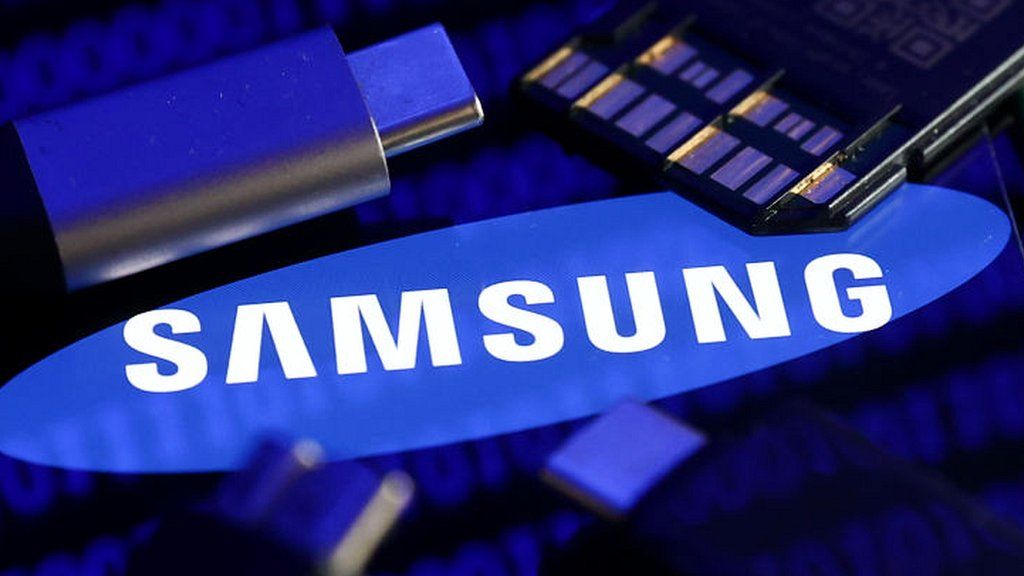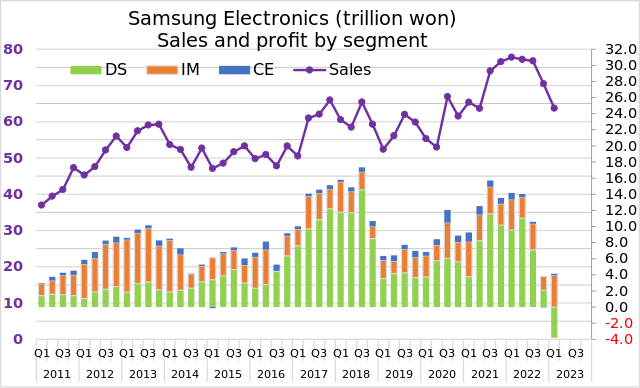Samsung Electronics, the world’s largest memory-chip and smartphone maker, reported a dismal second-quarter profit recently, as the global chip shortage and weak smartphone demand weighed on its performance.
The company posted an operating profit of 14 billion won ($11.7 million), down 99% from 14 trillion won ($11.7 billion) a year earlier, missing analysts’ expectations of 14.45 trillion won ($12.1 billion). Revenue for the quarter fell 81% to 14.7 trillion won ($12.3 billion), also below market estimates of 77 trillion won ($64.5 billion).

The chip business, which accounts for more than half of Samsung’s revenue and profit, saw its earnings plunge 98% year-on-year to 300 billion won ($251 million), as prices of DRAM and NAND flash chips dropped sharply due to oversupply and weak demand from smartphone makers.
Samsung said it faced “severe supply and demand imbalance” in the chip market, as the pandemic-induced surge in demand for servers and PCs last year led to a shortage of chips for other devices this year. The company also faced production disruptions at its Austin, Texas plant due to a winter storm in February, which further reduced its chip output.
The smartphone business, which competes with Apple and Chinese rivals, also suffered a 97% drop in operating profit to 300 billion won ($251 million), as sales of its flagship Galaxy S21 series fell short of expectations amid rising competition and inflation. Samsung said it sold 59 million smartphones in the quarter, down 18% from a year ago.
Samsung said it faced “weak seasonality” and “increased cost pressure” in the smartphone market, as consumers became more cautious about spending amid the pandemic and rising prices of raw materials and logistics. The company also faced challenges from the global chip shortage, which affected not only its own devices but also its component sales to other smartphone makers.

The only bright spot for Samsung was its display business, which posted a record operating profit of 13.4 trillion won ($11.2 billion), up 1,340% from a year ago, thanks to strong demand for OLED panels from major customers such as Apple and Chinese smartphone makers. Samsung said it benefited from “improved product mix” and “increased utilization” of its OLED production lines.
Samsung said it expects the chip market to recover gradually in the second half of the year, as supply conditions improve and demand from server customers remains solid. However, it warned that uncertainties remain due to the pandemic and geopolitical issues, and that it will continue to manage its inventory cautiously.
The company also said it expects the smartphone market to rebound in the second half, as it plans to launch new models such as the Galaxy Z Fold3 and Galaxy Z Flip3 foldable phones and the Galaxy Note21 series. However, it cautioned that cost pressure and component shortages will persist, and that it will focus on enhancing its premium leadership and product differentiation.
Samsung also announced that it will pay an interim dividend of 354 won ($0.30) per share for the second quarter, unchanged from a year ago.
Share to your social below!

Thanks for sharing. I read many of your blog posts, cool, your blog is very good.
купить аккаунт https://birzha-akkauntov-online.ru/
купить аккаунт аккаунт для рекламы
платформа для покупки аккаунтов услуги по продаже аккаунтов
продажа аккаунтов соцсетей купить аккаунт
маркетплейс для реселлеров купить аккаунт
аккаунты с балансом https://kupit-akkaunt-top.ru/
маркетплейс аккаунтов соцсетей https://pokupka-akkauntov-online.ru/
Marketplace for Ready-Made Accounts Account Trading
Account Sale Website for Buying Accounts
Purchase Ready-Made Accounts Verified Accounts for Sale
Account Acquisition Account Market
Profitable Account Sales Marketplace for Ready-Made Accounts
Account exchange Account marketplace
Ready-Made Accounts for Sale Sell Pre-made Account
Website for Buying Accounts Account Trading
Accounts marketplace Online Account Store
Online Account Store Accounts market
Find Accounts for Sale Account Trading
account exchange ready-made accounts for sale
website for buying accounts ready-made accounts for sale
accounts marketplace account acquisition
buy account account buying platform
accounts market find accounts for sale
database of accounts for sale accounts for sale
purchase ready-made accounts accounts for sale
account acquisition https://accountsmarketdiscount.com
account selling platform account trading platform
verified accounts for sale account exchange
account trading platform verified accounts for sale
buy accounts sell accounts
gaming account marketplace buy accounts
sell pre-made account sell accounts
ready-made accounts for sale website for selling accounts
account selling platform sell pre-made account
account selling platform find accounts for sale
website for selling accounts online account store
account store account market
sell accounts online account store
buy and sell accounts find accounts for sale
sell pre-made account account buying platform
purchase ready-made accounts account trading platform
sell accounts social media account marketplace
account catalog account selling platform
secure account sales account acquisition
account sale social media account marketplace
account trading https://top-social-accounts.org/
account purchase account market
website for selling accounts https://accounts-marketplace.xyz
accounts marketplace https://buy-best-accounts.org/
sell account https://social-accounts-marketplaces.live
guaranteed accounts https://accounts-marketplace.live
marketplace for ready-made accounts buy accounts
account store buy-accounts.space
website for buying accounts https://buy-accounts-shop.pro/
account trading service accounts marketplace
accounts market https://social-accounts-marketplace.live
account trading https://buy-accounts.live
guaranteed accounts https://accounts-marketplace.online/
secure account purchasing platform buy accounts
магазин аккаунтов akkaunty-na-prodazhu.pro
маркетплейс аккаунтов https://rynok-akkauntov.top/
маркетплейс аккаунтов соцсетей https://kupit-akkaunt.xyz
магазин аккаунтов akkaunt-magazin.online
маркетплейс аккаунтов соцсетей akkaunty-market.live
покупка аккаунтов https://kupit-akkaunty-market.xyz/
продажа аккаунтов akkaunty-optom.live
магазин аккаунтов https://online-akkaunty-magazin.xyz/
покупка аккаунтов https://akkaunty-dlya-prodazhi.pro/
продажа аккаунтов kupit-akkaunt.online
facebook ad account buy buy facebook accounts
facebook ad accounts for sale buy facebook accounts for advertising
buy facebook accounts cheap https://buy-ad-account.top
buy facebook accounts cheap https://buy-ads-account.click
buying facebook accounts buy account facebook ads
fb accounts for sale fb account for sale
fb accounts for sale https://ad-account-for-sale.top
buy fb ads account https://buy-ad-account.click
buy a facebook account https://ad-accounts-for-sale.work
buy adwords account https://buy-ads-account.top
buy aged google ads account https://buy-ads-accounts.click/
buying facebook ad account https://buy-accounts.click
buy google adwords accounts https://ads-account-for-sale.top
buy old google ads account https://ads-account-buy.work
buy google adwords accounts buy-ads-invoice-account.top
buy google ads threshold accounts buy google ads accounts
buy google ads verified account https://buy-ads-agency-account.top
buy verified google ads accounts buy google ads invoice account
unlimited bm facebook https://buy-business-manager.org
buy google ads verified account ads-agency-account-buy.click
buy google ad account buy google ads account
buy bm facebook buy facebook verified business account
buy facebook ads accounts and business managers buy business manager facebook
facebook business manager account buy buy-verified-business-manager-account.org
buy verified business manager facebook bm account buy
buy verified bm facebook business account for sale
buy verified facebook buy-business-manager-verified.org
buy verified bm facebook https://buy-bm.org
buy facebook bm account https://verified-business-manager-for-sale.org
buy facebook business manager https://buy-business-manager-accounts.org/
buy tiktok ads accounts https://buy-tiktok-ads-account.org
tiktok ad accounts https://tiktok-ads-account-buy.org
tiktok ad accounts https://tiktok-ads-account-for-sale.org
tiktok ads agency account https://tiktok-agency-account-for-sale.org
tiktok ads account buy https://buy-tiktok-ad-account.org
buy tiktok ads accounts https://buy-tiktok-business-account.org
tiktok agency account for sale https://buy-tiktok-ads.org
buy tiktok ads account https://tiktok-ads-agency-account.org